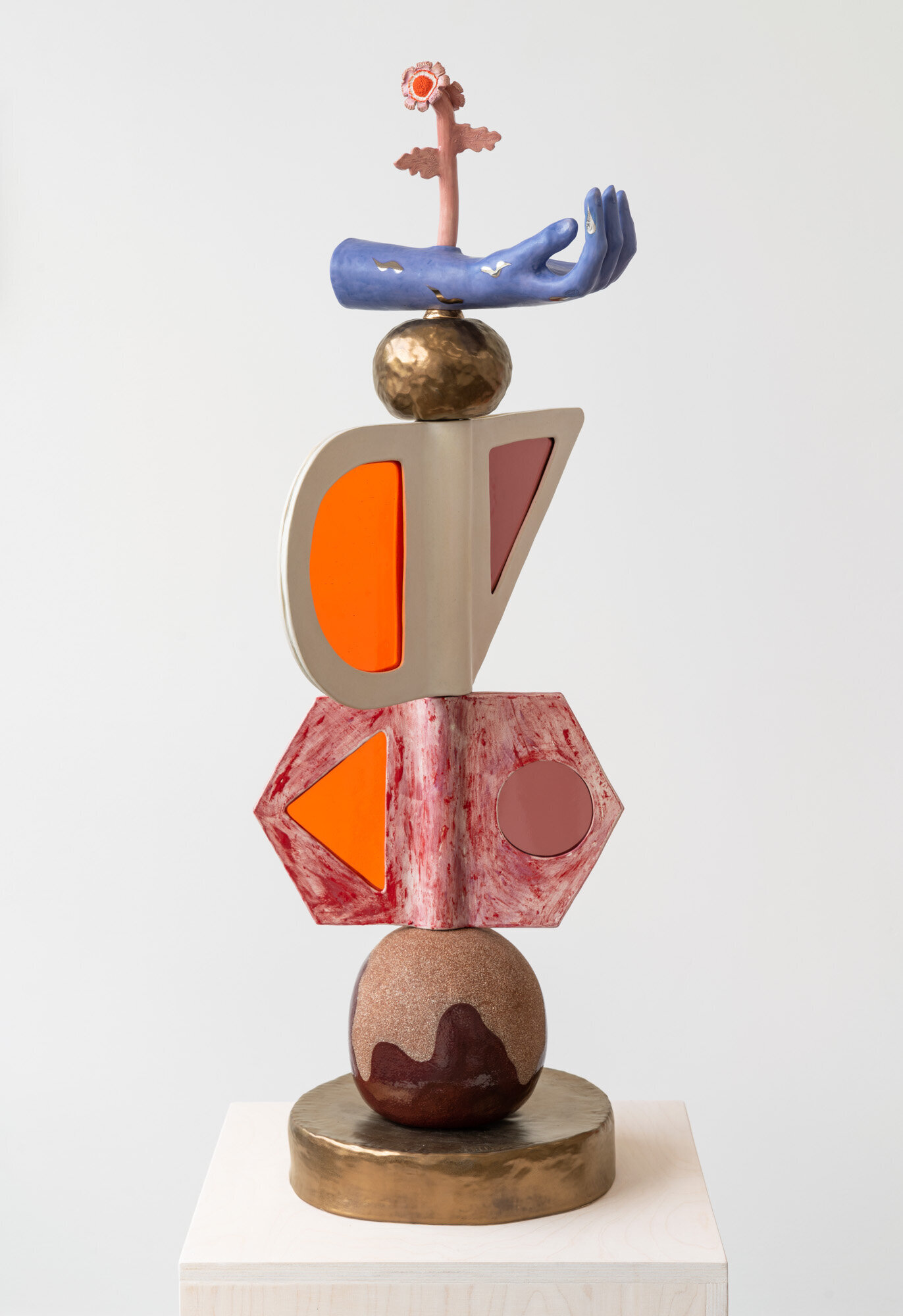Emily Counts "Souvenir"
By LINDSAY COSTELLO
Souvenir—to remember. It was one of the first French verbs I learned, and I was charmed by its connection to the English definition of souvenir. A keepsake, a relic, a token. Something small that retrieves a memory from deep below. What is this place in our minds that souvenirs reach? Objects conjure up our pasts. They can hold a mysterious power.
In Souvenir at Nationale, ceramic artist Emily Counts explores memory and intimacy through mystic objects centering nature and the body. Counts emphasizes the varying relationships between her objects and experiments with object utility, bringing human-object associations to the forefront. Over the last year, touch and connection have been absent from many of our lives. In light of this, Counts’s work feels much-needed, but it also looks toward the future. How do we process memory now? Does memory live in our objects, or in our bodies, in the same way?
Emily Counts, It Means What You Feel (2021). Glazed stoneware with gold luster, walnut wood, stained glass, cotton rope, copper, hardware. 29” x 49” x 4.5”.
Many of Counts’ works are exercises in connection. In both Gold and Yellow Pitchers and Two Futures, vase handles are linked together, forever uniting the objects. I find myself wondering how this alters their function—how does an object change when it can no longer be held in the same way? This question seems to hint at Counts’s ongoing theme of nostalgia. In It Means What You Feel, a stoneware chain and walnut wall piece join abstract shapes, flowers, and a mushroom. This persistent focus on tethering emphasizes Counts’ interest in relationship, intimacy, and touch. Even her use of mushrooms, one of Souvenir’s central motifs, moves beyond a general interest in the natural world to reflect on underground mycelial networks.
Emily Counts, Two Futures (2021). Glazed stoneware with gold luster. 12” x 7” x 5”.
Counts’ stacked towers also feel like connective devices. Objects of varying shape, luminosity, transparency, luster, and color unite in these forms; atop Tower of Windows, a sculpted hand and flower unite, as though they’ve grown from the mixture of objects balanced underneath them. Observing Counts’s towers, Brancusi springs to mind most quickly, but so do Henri Laurens and Barbara Hepworth, both of whom create bodily, elongated sculptures. Counts finds an original path forward by intermingling both geometric and organic shapes. In Tower of Windows, her use of gold luster, a disembodied hand, and stained glass feels reverent and ritualistic. With a delicate flower balancing atop the tower, the entire piece feels like an ode to nature.
Emily Counts, Tower of Windows (2021). Glazed stoneware with gold luster, stained glass, epoxy clay, iron, steel. 39” x 18” x 13”.
For Counts, nature and the body are intertwined. Flowers are central characters, installed alone, gathered in vases, used as surface decoration, and draping from chains. Similarly, bodies are seen in many of Counts’s works. In some instances, the body even becomes a makeshift domestic object, further highlighting the importance of human-object relationships and the potential for objects to hold memory. In Woman With Sweater, Grandmother’s Powers, and Orange Witch, Counts’s take on sculptured busts are lit from within by multicolored bulbs. Light pours through each surreal figure’s jumbled facial features. These lamps serve as a potent reminder of how memory begins with the senses.
Emily Counts, Woman With Sweater (2021). Glazed stoneware with gold luster, electrical components, and lighting. 15” x 11” x 6.5”.
Counts’ aesthetic choices remind me of 1960s-70s decor—they’re bright, warm, and retro, yet don’t feel outdated. I think of mid-century textile designers like Lucienne Day, Jacqueline Groag, and Heal’s Fabrics; even Pucci would appreciate Counts’ bold palette. Following this psychedelic thread, Counts’ works also feel like a trip into her subconscious. Recognizable forms—women, flowers, household objects, chains—become slightly off-kilter in her world. Counts’s stylized, distorted forms feel more magical than cartoonish. Metallics shine alongside a vivid yellow, red, and pink glazes, enchanting like the outdoors in summer.
Counts’ sculptures denote a strong, specific love found between human and object. We’re accustomed to this love during childhood, but somewhere down the line, we forget about it. Our attachment to objects is seen as materialistic. We often disregard the strong memories that objects retain. Counts prompts us to remember by creating sculptures that hint at memories. Her works suggest the magical power of human-object relationships; Counts’s sculptures are almost-toys, innocent and surreal.
As much as she honors the object, however, Counts’s work also speaks to even wider themes of intimacy and memory held within the body and within nature. This is where her warm, earthen, retro-psychedelic aesthetic sense shines through. Bodies, flora, and fungi coexist in symbiosis within Counts’s world. They honor memories of the past, but also look forward. They conjure a magical future.
Emily Counts Souvenir is on view at Nationale, Portland, OR from April 22 - July 8, 2021
Lindsay Costello is an artist, writer, and herbalist-in-training in Portland, OR. She has written art criticism for Hyperallergic, Art Papers, Art Practical, Oregon Arts Watch, and many other publications.




